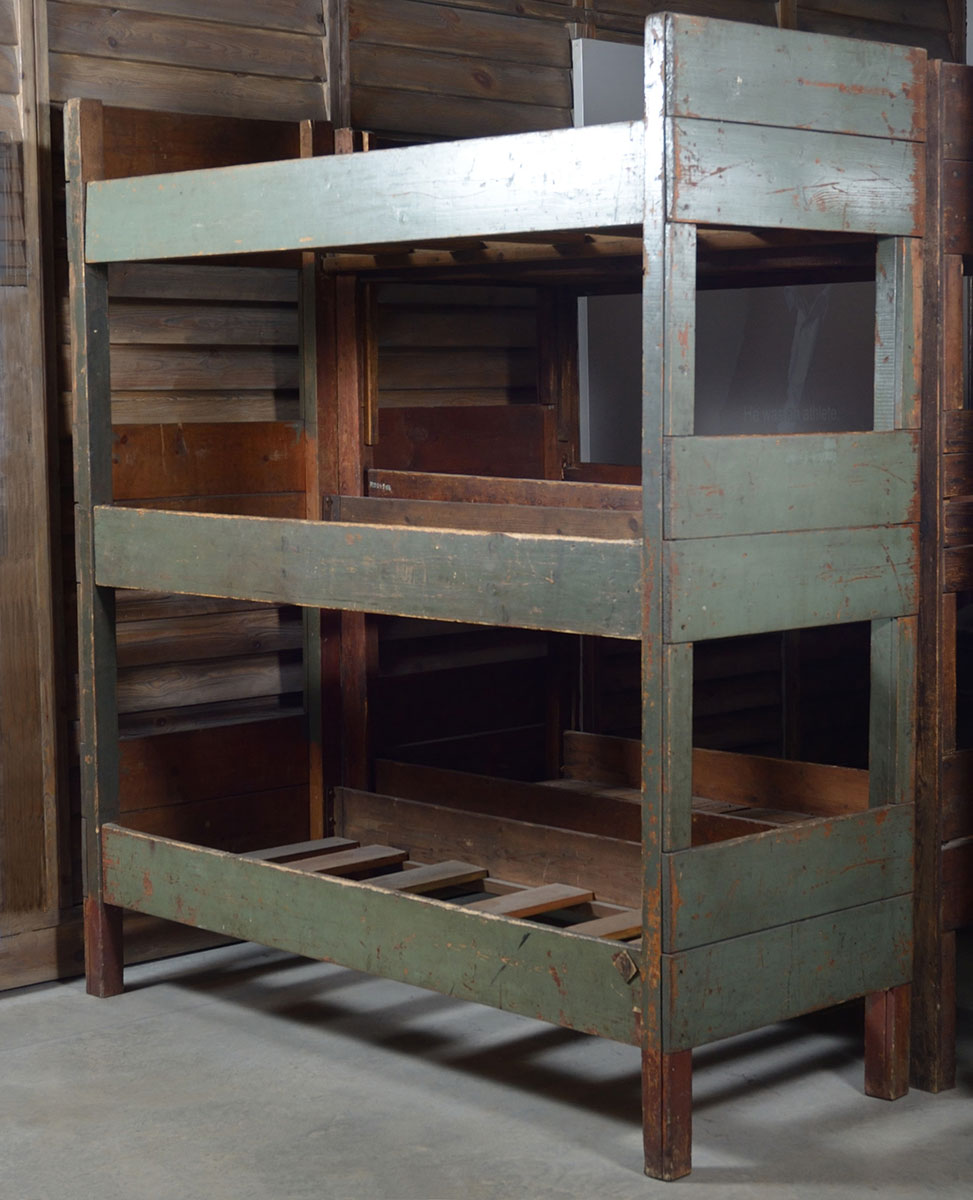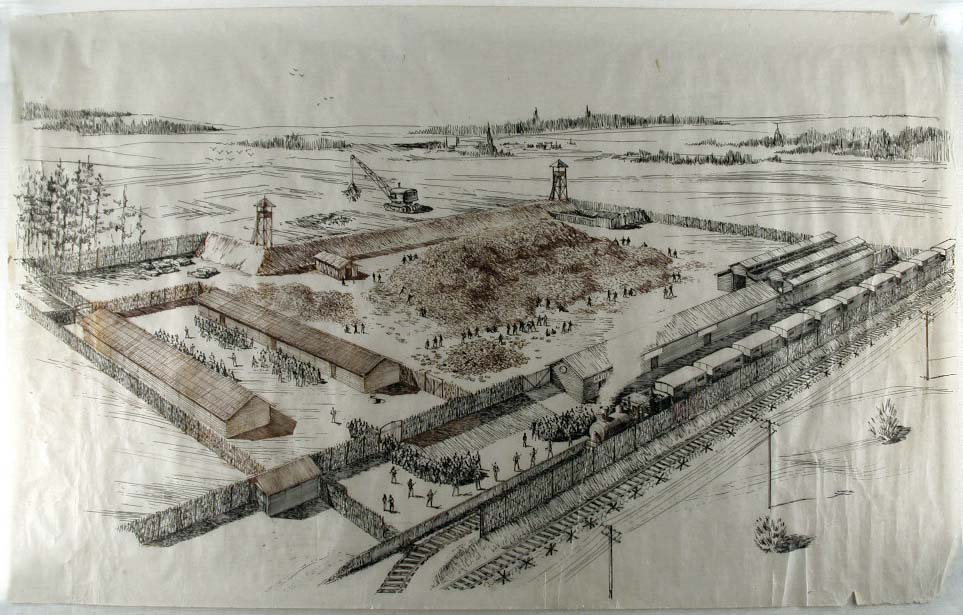Yad Vashem Photo Archives 7957/3

When she was over sixty years old, Karolina Steiner from Zabok, Croatia, was sent to the Djakovo camp. When she arrived, her clothes were replaced with an inmate’s outfit. An acquaintance, who worked at sorting clothing, recognized the lace blouse she had worn when she arrived in the camp, and kept it.Karolina perished in the camp, and, at war’s end, the blouse was given to her family.
Yad Vashem Artifacts Collection
Gift of Miriam Steiner Aviezer, Givataim, Israel


Chelmno was the first death camp used for mass murder by gas. Approximately 320,000 Jews were murdered at Chelmno. The victims’ belongings were found in excavations carried out by the director of the site in Poland in the 1990s.
Yad Vashem Artifacts Collection
Loaned by Muzeum Bylego Obozu Zaglady Chelmno nad Nerem, Poland


The gas arrived at the camps in solid form, in sealed metal canisters. Contact with air turns the crystals to fatal gas that asphyxiates within minutes. Someone wearing a gas mask would pour the crystals through a small opening into the sealed gas chamber filled with victims.
Yad Vashem Artifacts Collection
Loaned by Państwowe Muzeum na Majdanku, Poland


The leg chains were donated by Shimon Srebrenik, one of the three survivors of the camp.
Yad Vashem Artifacts Collection
Donated by Shimon Srebrenik, Nes Ziona, Israel


Yad Vashem Artifacts Collection
Loaned by Panstwowe Muzeum Auschwitz-Birkenau, Oswiecim, Poland


Collection of the Yad Vashem Art Museum, Jerusalem
Gift of the artist

Chelmno was the first extermination camp that the Germans established on Polish soil. Murder operations began there on December 8, 1941, and continued intermittently until January 1945. The Jews of the Lodz ghetto and the vicinity were the primary victims deported to Chelmno, where they were murdered by means of gas vans. When the deportees reached the camp, they were ordered to undress, stripped of their belongings, and tricked into boarding a van whose exhaust pipe was actually connected to its interior. After the doors were closed, the van began to drive toward a designated burial place in a nearby forest. No one survived. By using three gas vans, nearly 300,000 Jews and 5,000 Sinti and Roma were murdered in Chelmno. Only three Jews survived this death camp.
Starting in March 1942, after the guidelines for action were worked out at the Wannsee Conference, the Germans established three extermination camps at the eastern boundary of the Generalgouvernement, not far from main railroad lines: Belzec (established in March 1942, this camp functioned until December of that year; in the spring of 1943, the cremation of bodies began in order to cover up the traces of the murders committed); Sobibor (May-July 1942, and October 1942-October 1943); and Treblinka (July 1942-August 1943).
The Nazis’ purpose in building these camps was to carry out the systematic murder of European Jewry as part of the Final Solution. Permanent gas chambers were constructed in these camps. No selections were performed in these camps. As the deportation trains arrived, the victims – men, women, and children – were sent directly to the gas chambers. Approximately 1,700,000 Jews, mostly from Poland, were murdered in these three extermination camps.
A standard method of extermination was used in these three camps: carbon monoxide from large tank engines was released into sealed chambers. The victims were stripped of their clothing and crowded into the gas chambers where they died of suffocation within a short time. The corpses were removed by Jewish slave laborers and thrown into large pits. The corpses were later burned in an attempt to destroy any evidence left behind. The entire process of murder took only a few hours and the camps would process and murder numerous transports in the same day.
Majdanek was established in late 1941, for Soviet prisoners of war and as a concentration camp for Poles. The gas chambers and crematoria were built in 1942. In the spring of that year, thousands of Jews, Slovaks, Czechs, Germans, and Poles were murdered in Majdanek. The camp operated until the Soviet army liberated the Lublin area in July 1944. Approximately 78,000 people were murdered in Majdanek.
Only a small percentage of those who arrived in transports in 1944 to the remaining death camps – Auschwitz, Majdanek and Chelmno – were selected for dispatch to labor. They were chosen for various tasks in the extermination process such as sorting through and packing the clothing and possessions of the victims, and burying and disposing of the bodies by burning them. This latter group of Jews was part of the Sonderkommando units, special units that worked under cruel and terror-ridden conditions. These workers were often sent to be murdered in the gas chambers after a few months and replaced with “new” prisoners.
The others – women, men, children, the elderly, and those whose strength had failed during their brief internment in the camp – were taken straight to the gas chambers. Transports and extermination continued until late 1944. Although Himmler ordered an end to the murders in gas chambers, prisoners continued to die of exhaustion, starvation, and disease.


